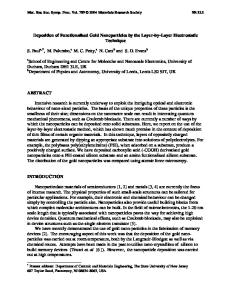Application of the Electrophoretic Deposition Technique for the Development of Electrodes Containing a Catalyst Layer of
- PDF / 1,234,956 Bytes
- 12 Pages / 432 x 648 pts Page_size
- 77 Downloads / 371 Views
MRS Advances © The Author(s), 2020, published on behalf of Materials Research Society by Cambridge University Press DOI: 10.1557/adv.2020.379
Application of the Electrophoretic Deposition Technique for the Development of Electrodes Containing a Catalyst Layer of Nanostructured Pt-Sn/C for DAFCs D. González-Quijano1,*, W.J. Pech-Rodríguez2, L.E. Verduzco3, J.I. EscalanteGarcía4, G. Vargas-Gutiérrez4, F.J. Rodríguez-Varela3 1
Centro de Ciencias de la Ingeniería, Universidad Autónoma de Aguascalientes Campus Sur, Av. Prol. Mahatma Gandhi 6601, Col. El Gigante, Aguascalientes, Aguascalientes, México, C.P. 20340.
2
Universidad Politécnica de Victoria, Av. Nuevas Tecnologías 5902, Parque Científico y Tecnológico de Tamaulipas, Ciudad Victoria, Tamaulipas, C.P. 87138, México.
3
Sustentabilidad de los Recursos Naturales y Energía, Cinvestav Unidad Saltillo, Av. Industria Metalúrgica 1062, Parque Industrial Ramos Arizpe. Ramos Arizpe, Coahuila, C.P. 25900, México
4
Ingeniería Metalúrgica e Ingeniería Cerámica, Cinvestav Unidad Saltillo.
*
Corresponding author, e-mail: [email protected]
Abstract
A catalyst layer of Pt-Sn/C (Pt:Sn 1:1 atomic ratio) was deposited on commercial carbon cloth electrodes by electrophoretic deposition (EPD). The Pt-Sn/C nanocatalyst was synthesized by the polyol method. Three current signals were applied: i) continuous direct 1
Downloaded from https://www.cambridge.org/core. Rice University, on 26 Oct 2020 at 10:23:04, subject to the Cambridge Core terms of use, available at https://www.cambridge.org/core/terms. https://doi.org/10.1557/adv.2020.379
current (CDC); ii) positive pulsed current (PPC); and iii) asymmetric alternating current (AAC). The chemical composition analysis showed the effect of the applied signal on species transferred onto the carbon cloth to form the catalyst layers. Evaluation by SEM confirmed the effect of deposition-signal on the morphology of the catalyst layer. The CDC signal formed spherical agglomerates with irregular distribution along with carbon fibers over the electrode, showing some cracks. A cross-cut view of the electrode showed that the catalyst penetrated the carbon cloth. Meanwhile, the PPC signal promoted a better deposition of the catalyst layer over the carbon cloth surface, with a thicker and more homogeneous rough layer than CDC. In contrast, the layer developed by the AAC signal showed a morphology similar to that by CDC, suggesting the formation of a layer with low metal loading. The cross-cut view of the AAC electrode showed the formation of a highly rough layer having large areas with limited contact with the carbon cloth fibers. The electro-catalytic activity of the electrodes for the Ethanol Oxidation Reaction (EOR) was studied in acid media. The CDC electrode showed an enhanced performance for the EOR by delivering the highest current density (272 mA mg-1Pt) with the more negative onset potential (341 mV) relative to the PPC and AAC electrodes.
INTRODUCTION For years, low temperature fuel cells, among them Direct Alcohol Fuel Cell
Data Loading...











